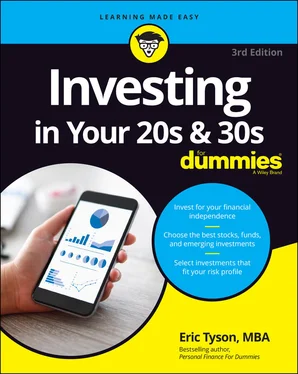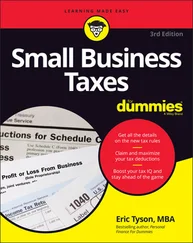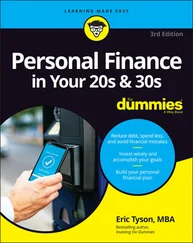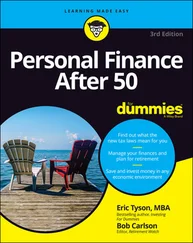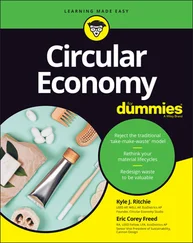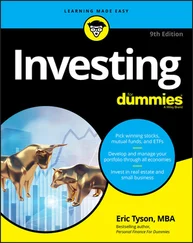Eric Tyson - Investing in Your 20s & 30s For Dummies
Здесь есть возможность читать онлайн «Eric Tyson - Investing in Your 20s & 30s For Dummies» — ознакомительный отрывок электронной книги совершенно бесплатно, а после прочтения отрывка купить полную версию. В некоторых случаях можно слушать аудио, скачать через торрент в формате fb2 и присутствует краткое содержание. Жанр: unrecognised, на английском языке. Описание произведения, (предисловие) а так же отзывы посетителей доступны на портале библиотеки ЛибКат.
- Название:Investing in Your 20s & 30s For Dummies
- Автор:
- Жанр:
- Год:неизвестен
- ISBN:нет данных
- Рейтинг книги:4 / 5. Голосов: 1
-
Избранное:Добавить в избранное
- Отзывы:
-
Ваша оценка:
- 80
- 1
- 2
- 3
- 4
- 5
Investing in Your 20s & 30s For Dummies: краткое содержание, описание и аннотация
Предлагаем к чтению аннотацию, описание, краткое содержание или предисловие (зависит от того, что написал сам автор книги «Investing in Your 20s & 30s For Dummies»). Если вы не нашли необходимую информацию о книге — напишите в комментариях, мы постараемся отыскать её.
Discover your unique investing style!
Inside. . .
Learn how to start investingChoose stocks and funds wiselyMinimize your tax billDecide how much to investGet into real estateManage your level of riskInvest in small businessDiversify your portfolio
Investing in Your 20s & 30s For Dummies — читать онлайн ознакомительный отрывок
Ниже представлен текст книги, разбитый по страницам. Система сохранения места последней прочитанной страницы, позволяет с удобством читать онлайн бесплатно книгу «Investing in Your 20s & 30s For Dummies», без необходимости каждый раз заново искать на чём Вы остановились. Поставьте закладку, и сможете в любой момент перейти на страницу, на которой закончили чтение.
Интервал:
Закладка:
Understanding Risks and Returns
Who among us wants to lose money? Of course you don’t! You put your money into an investment in the hope and expectation that you will get back more in total than you put in. And you’d rather your chosen investments not fluctuate too widely in value. When it comes to investing, no concepts are more important to grasp than risk and return, which I explain in this section.
Realizing risks
The investments that you expect to produce higher returns (such as stocks) fluctuate more in value, particularly in the short term. However, if you attempt to avoid all the risks involved in investing, you probably won’t succeed, and you likely won’t be happy with your investment results and lifestyle. In the investment world, some people don’t go near stocks or real estate that they perceive to be volatile, for example. As a result, such investors often end up with lousy long-term returns and expose themselves to some high risks that they overlooked, such as the risk of inflation and taxes eroding the purchasing power of their money.
You can’t live without taking risks. Risk-free activities or ways of living don’t exist. You can sensibly minimize risks, but you can never eliminate them. Some methods of risk reduction aren’t palatable because they reduce your quality of life.
Risks are also composed of several factors. Following are the major types of investment risks and a few of the methods you can use to reduce these risks while not missing out on the upside that investments offer:
Market-value risk: Although stocks can help you build wealth, they can also drop 20 percent or more in a relatively short period of time. Entering 2020, who was thinking about how a pandemic and the government’s response might impact stock prices? Then, in a few weeks, stocks slid more than 30 percent due to government-mandated economic shutdowns. Although real estate, like stocks, has been a rewarding long-term investment, various real estate markets get clobbered from time to time.
Individual-investment risk: A down market can put an entire investment market on a roller-coaster ride, but healthy markets also have their share of individual losers. Just as individual stock prices can plummet, so can individual real estate property prices. With lending investments, you have a claim on a specific amount of a currency. Occasionally, currencies falter. Most folks ignore this low frequency but very high impact risk when thinking about lending investments.
Purchasing-power risk: Inflation — which is an increase in the cost of living — can erode the value of your money and its purchasing power (what you can buy with that money). I often see skittish investors keep their money in bonds and money market accounts, thinking that they’re playing it safe. The risk in this strategy is that your money won’t grow enough over the years for you to accomplish your financial goals. In other words, the lower the return you earn, the more you need to save to reach a financial goal. As a younger investor with so many years and decades of investing in your future, you need to pay the most attention to the risk of generating low returns.
Liquidity risk: Some investments are more liquid (how quickly an investment can be converted to cash) than others and more readily sold at fair market value on short notice. Bank savings accounts have no real liquidity risk. A real estate investment, by contrast, takes time and money to sell, and if you must sell most real estate quickly, you’ll likely get a fair amount less than its current full market value.
Career risk: In your 20s and 30s, your ability to earn money is probably your biggest asset. Education is a lifelong process. If you don’t periodically invest in your education, you risk losing your competitive edge. Your skills and perspectives can become dated and obsolete. Although that doesn’t mean you should work 80 hours a week and never do anything fun, it does mean that part of your “work” time should involve upgrading your skills.
Managing risks
Throughout this book as I discuss various investments, I explain how to get the most out of each one. Because I’ve introduced the important issue of risk in this chapter, I would be remiss if I also didn’t give you some early ideas about how to minimize those risks. Here are some simple steps you can take to lower the risk of investments that can upset the achievement of your goals:
Do your homework. When you purchase real estate, various inspections, for example, can save you from buying a money pit. With stocks, you can examine some measures of value and the company’s financial condition and business strategy to reduce your chances of buying into an overpriced company or one on the verge of major problems.
Diversify. Placing significant amounts of your capital in one or a handful of securities is risky, particularly if the stocks are in the same industry or closely related industries. To reduce this risk, purchase stocks in a variety of industries and companies within each industry. Even better is buying diversified mutual funds and exchange-traded funds. Diversifying your investments can involve more than just your stock portfolio. You can also hold some real estate investments to diversify your investment portfolio. If you worry about the health of the U.S. economy, the government, and the dollar, you can reduce your overall investment risk by also investing overseas so that you have a globally diversified portfolio of stocks. Most large U.S. companies do business overseas, so when you invest in larger U.S. company stocks, you get some international investment exposure. You can also invest in international company stocks, ideally through funds.
Minimize holdings in costly markets. Although I don’t believe that most investors can time the markets — buy low, sell high — spotting a greatly overpriced market isn’t too difficult. You should avoid overpriced investments because when they fall, they usually fall farther and faster than more fairly priced investments. Also, you should be able to find other investments that offer higher potential returns. Throughout this book, I explain some simple yet powerful methods you can use to measure whether a particular investment market is of fair value, of good value, or overpriced.
View market declines in a different light. Instead of seeing declines and market corrections as horrible things, view them as potential opportunities or “sales.” If you pass up the stock and real estate markets simply because of the potential market-value risk, you miss out on a historic, time-tested method of building substantial wealth. Try not to give in to the human emotions that often scare people away from buying something that others seem to be shunning.
Making sense of returns
Each investment has its own mix of associated risks that you take when you part with your investment dollar and, likewise, offers a different potential rate of return. When you make investments, you have the potential to make money in a variety of ways.
To determine how much money you’ve made or lost on your investment, you calculate the total return. To come up with this figure, you determine how much money you originally invested and then factor in the other components, such as interest, dividends, and appreciation or depreciation.
If you’ve ever had money in a bank account that pays interest, you know that the bank pays you a small amount of interest in exchange for your allowing the bank to keep your money. The bank then turns around and lends your money to some other person or organization at a much higher rate of interest. The rate of interest is also known as the yield. So if a bank tells you that its savings account pays 1.5 percent interest, the bank may also say that the account yields 1.5 percent. Banks usually quote interest rates or yields on an annual basis. Interest that you receive is one component of the return you receive on your investment.
Читать дальшеИнтервал:
Закладка:
Похожие книги на «Investing in Your 20s & 30s For Dummies»
Представляем Вашему вниманию похожие книги на «Investing in Your 20s & 30s For Dummies» списком для выбора. Мы отобрали схожую по названию и смыслу литературу в надежде предоставить читателям больше вариантов отыскать новые, интересные, ещё непрочитанные произведения.
Обсуждение, отзывы о книге «Investing in Your 20s & 30s For Dummies» и просто собственные мнения читателей. Оставьте ваши комментарии, напишите, что Вы думаете о произведении, его смысле или главных героях. Укажите что конкретно понравилось, а что нет, и почему Вы так считаете.
